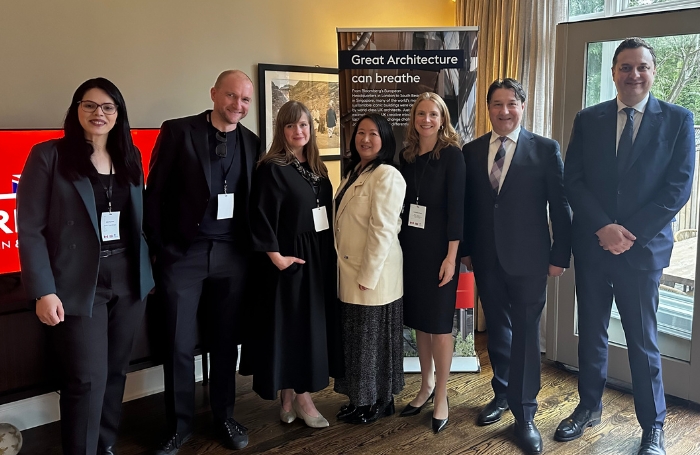Eligible architects registered in the UK or Canada can benefit from a process in either country from 14 May 2025, following the latest mutual recognition agreement (MRA) signed by the and its Canadian counterpart in April.
ARB chair Alan Kershaw says the agreement with Canada’s (ROAC) opens significant new opportunities for collaboration and will build on the strong professional partnership that already exists between the two countries.
The streamlined process involves obtaining a letter of good standing from your home-country regulator followed by a light assessment to ensure you understand what is necessary to practice safely and effectively in the country where you wish to register.
The MRA applies to:
- UK to Canada – architects registered with ARB who have ARB-accredited qualifications and those who have registered by passing the Prescribed Exam at Part 1 and Part 2 level and completing a UK Part 3.
- Canada to UK – architects who have obtained Canadian Architectural Certification Board (CACB)-accredited qualifications or who have achieved the same standard following certification and have additionally completed the Canadian experience requirement and licensing examination.
Interested applicants should begin the process by getting further information - including application forms - from the website of the regulator where they are currently registered:

What is the landscape like for architecture in Canada?
Tim Davis arrived in Canada as a newly-qualified UK architect over 30 years ago, setting up in Ottawa after a short period with a large practice came to a close when hockey arena project they had ended.
Despite attracting some high-profile clients and projects, Tim says his practice has always been excluded from applying for most government opportunities due to the lack of Canadian registration and has faced limits on the size and types of jobs they could apply for permits for in Ontario. He says Canadian registration will open up a whole new world of opportunities.
“The UK/Canada MRA has been a long time coming. It’s something that I have hoped for over many years,” he says. “Not being able to refer to myself as an architect after everything that I went through to obtain that status in the UK has gnawed away at me personally for years.”
He continues: “Although I am close to the end of my career, I will be overjoyed to receive Canadian Architect status if this is possible. Having said all this, English qualifications are highly regarded generally in Canada, and my being a RIBA member has been core to our success here.”

What are the benefits of the mutual recognition agreement to architects?
has had a studio in Toronto for the past 18 months. Jon Kaminsky, who leads the team on the ground there, says there is a lot of work going on, with Toronto the fastest growing city in Canada.
The studio has been working up till now with local collaborators and architectural counterparts, not only because it values creative collaboration, but because it cannot sign off its own drawings due to compliance restrictions.
“The MRA changes things dramatically,” he says. “We can now call ourselves architects in Ontario and mean it! It opens doors to work as we want to work," he says. "Not all projects warrant having two architecture teams to design the project and it’s a difficult sell to a cost-conscious client. With mutual professional recognition, architects on both sides of the Atlantic can now collaborate more freely, driven by purpose rather than necessity,” says Jon.
He says he is genuinely excited by the prospect of being one of the first to benefit from the MRA, a process he has already begun. He was about 18 months into ROAC’s Broadly Experienced Foreign Architect (BEFA) pathway, the standard route to have your foreign qualifications recognised, and expected completion to take another year.
The MRA is structured quite differently, he explains. Although there is still a competency evaluation involved, it places greater emphasis on the quality of an architect’s existing qualifications and the credibility of the issuing licensing authority, rather than on any in-depth assessment of the individual.
“For younger professionals, this really is a game changer,” he suggests. “Imagine being able to move to another country and through a few clear, evidence-based steps become fully qualified without the need to retrain from scratch. It opens up incredible opportunities for the exchange of ideas and experiences on both sides.”
For decades, architects in Canada have had the ability to quickly and easily register in other provinces and territories - UK architects will have the same ability once they are registered with their first jurisdiction. They will have the same ease of registration as Canadian-registered architects, with this MRA ensuring that no additional requirements will be imposed.
Thanks to Tim Davis, Principal, Tim Davis Design Inc; Jon Kaminsky, Associate Director, Hawkins\Brown.
Text by Neal Morris. This is a Professional Feature edited by the RIBA Practice team. Send us your feedback and ideas.
RIBA Core Curriculum topic: Legal, regulatory and statutory compliance.
As part of the flexible RIBA CPD programme, professional features count as microlearning. See further information on the updated RIBA CPD core curriculum and on fulfilling your CPD requirements as an RIBA Chartered Member.



